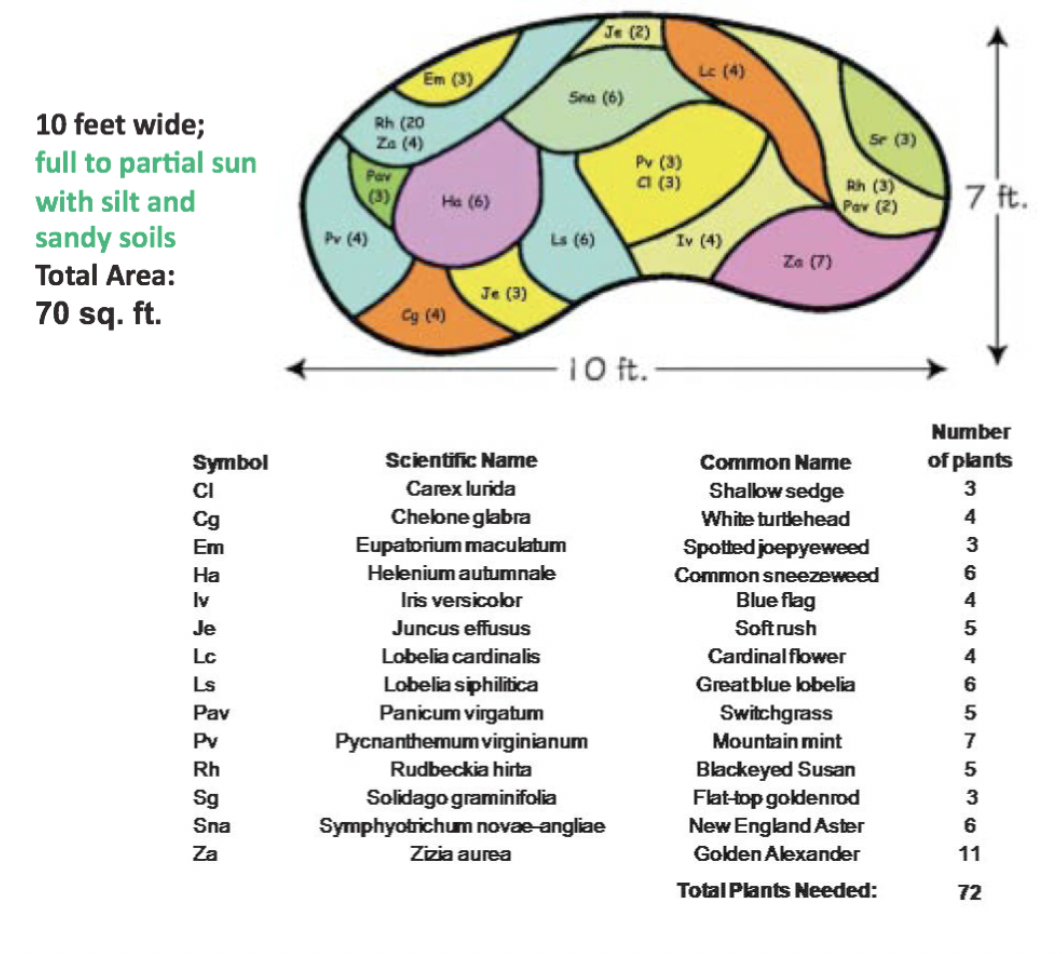Rain Gardens
New ResidentialWhat are Rain Gardens?
Rain gardens, also referred to as vegetated swales and bioswales, consist of sloped depressions in the landscape planted densely with native plants that can soak up and filter stormwater runoff from rooftops, streets, or driveways (see Native and Adapted Plants). Rain garden vegetation absorbs and filters stormwater before it enters storm drains.

Figure 1 – A sample rain garden design and plant list (Source: The Native Plant Society of New Jersey).
How to Implement a Rain Garden
Place rain gardens to capture runoff from a site effectively. Observe the site during the next rain and note where runoff problems exist. Consider the following:
- Does it come from a roof or downspout?
- Is there runoff from the driveway?
- Does the runoff gravitate towards one place more than another?
Work with landscape architects to incorporate a rain garden early in the design process. As a general rule of thumb, place the rain gardens at least 10 feet from building foundations if the structure has a basement; for residences without basements, place rain gardens at least 2 feet from the home.[1]
For step-by-step guidance on installing a rain garden, see The Rutgers Water Resources Program and the Native Plant Society of New Jersey’s Rain Garden Manual of New Jersey.
Examples
New Jersey Demonstration Rain Gardens
The Rutgers NJ Agricultural Experiment Station’s Water Resources Program has installed over 125 demonstration rain gardens in New Jersey.
Benefits
On average, New Jersey receives 44 inches of rain per year, which flows untreated into storm drains and local water bodies resulting in pollution and poor water quality.[2] Rain gardens provide a low-cost, low-tech method for reducing the amount of runoff that enters streams and rivers.
Reduced stormwater runoff and increased groundwater recharge – As stormwater runoff flows into rain gardens, much of it is absorbed back into the soil, increasing groundwater recharge and reducing runoff into storm drains and waterways (see Pervious Paving Materials).
Filtering and cleaning water before it enters storm drains – Plants in rain gardens filter stormwater, improving water quality and allowing sediment to settle out instead of clogging storm drains.
Habitat Creation and Increased Amount of Native Vegetation – Rain gardens designed with native plants increase biodiversity and provide habitat for birds, butterflies, and other wildlife and provide opportunities for views and connection with nature (see Biophilic Design, Wildlife Habitat, and Sense of Place).
Costs
The cost for a residential-size rain garden ranges from $3-5 per square foot, depending on existing soil conditions, selection of plants, and whether or not a homeowner chooses to hire professional labor or to complete the project on their own.[3]
See the Rain Garden Cost Calculator to estimate costs based on the size and selection of plants for a typical residential rain garden in the Northeast.
Resiliency
Green infrastructure such as rain gardens integrates resilient and green design to complement and reduce reliance on traditional grey infrastructure. For example, rain gardens help to increase stormwater infiltration, reducing stress on municipal sewer systems during heavy rain events and help to recharge groundwater during periods of drought. Rain gardens support ecological resilience by increasing the biological diversity of native plants and animals in a given area, which in turn, enhances the ability of the natural system to rebound after a disturbance.
[1] The Rutgers Cooperative Extension Water Resources Program and the Native Plant Society of New Jersey’s Rain Garden Manual of New Jersey http://water.rutgers.edu/Rain_Gardens/RGWebsite/RainGardenManualofNJ.html (accessed April 2, 2018).
[2] Rutgers NJAES. “Rain Gardens Fact Sheet: Rain Gardens.” http://water.rutgers.edu/Rain_Gardens/fs513.pdf (accessed March 25, 2018).
[3] Sustainble Jersey. 2017. Rain Gardens Action. http://www.sustainablejersey.com (accessed April 2, 2018).
Related Strategies
Resources
- Jersey-Friendly Yards
- Landscape for Life
- Low Impact Development Center – Rain Garden Template
- Native Plant Society of New Jersey
- Native Plant Database
- NJ DEP
- Rain Gardens – A Design Guide by the University of Connecticut
- Rutgers NJ Agricultural Experiment Station – Water Resources Program
- The Sustainable Sites Initiative
- Sustainable Jersey
- US EPA
